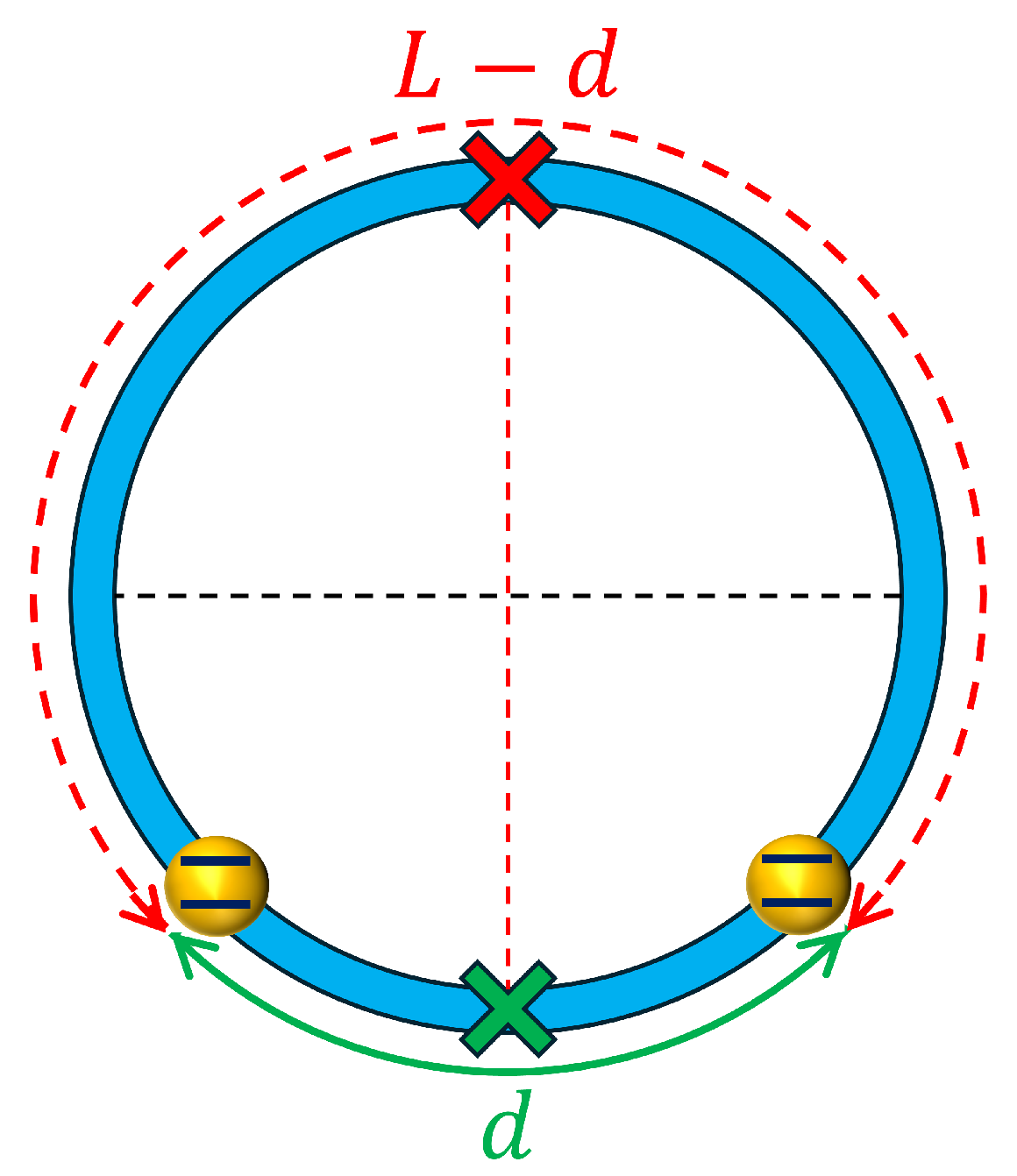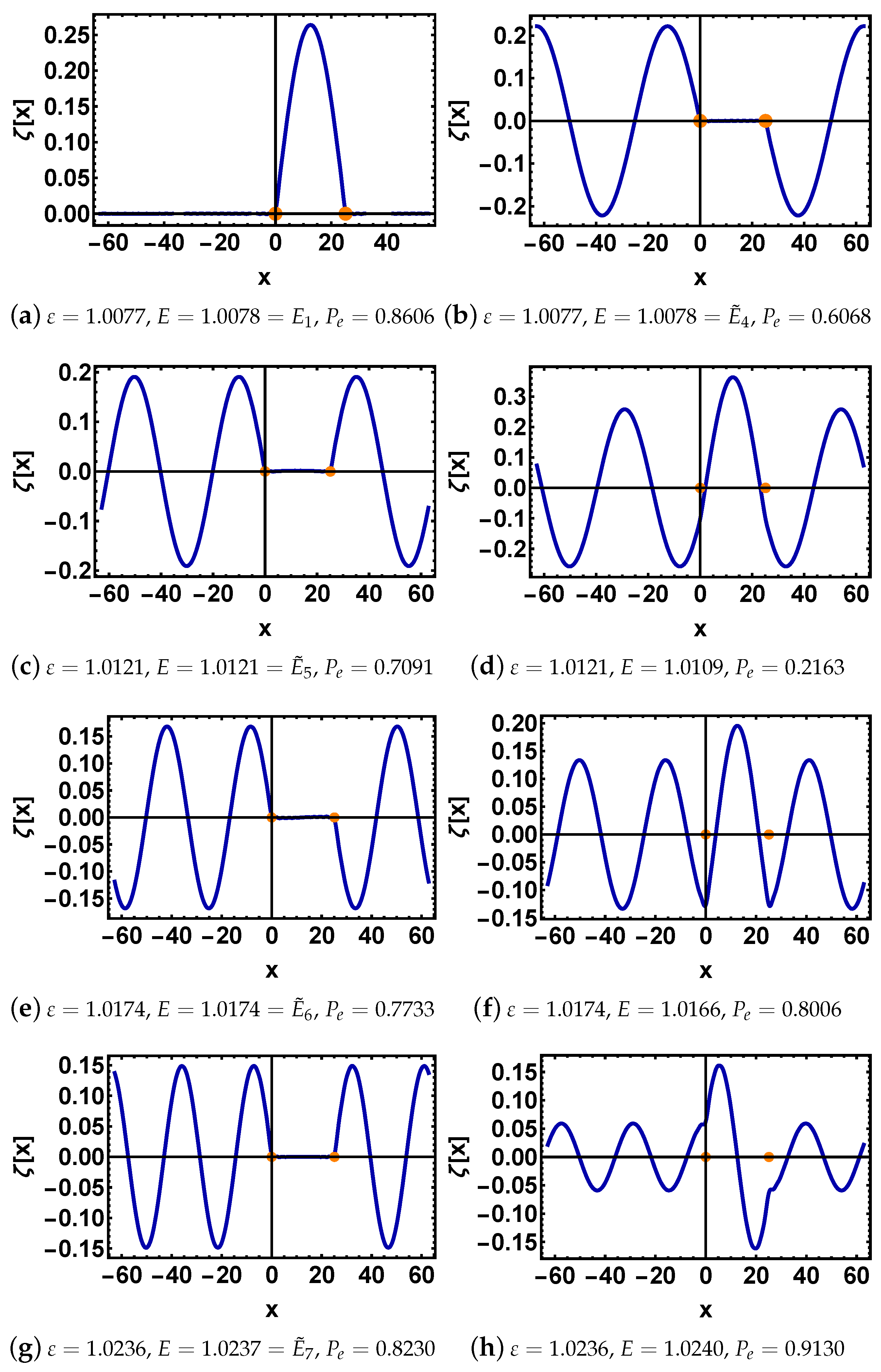Quasi-Degenerate Resonant Eigenstate Doublets of Two Quantum Emitters in a Closed Waveguide
Abstract
1. Introduction
2. Model and Symmetries
3. Doublets of Resonant Eigenstates
3.1. Case 1:
- for some value of , the eigenvalue of one or both states with the largest exactly matches a resonance energy;
- there exist a possible degenerate or quasi-degenerate doublet of resonant states, well-separated in energy from the rest of the spectrum.
3.2. Case 2:
4. Conclusions and Outlook
Author Contributions
Funding
Institutional Review Board Statement
Informed Consent Statement
Data Availability Statement
Acknowledgments
Conflicts of Interest
Abbreviations
| BIC | Bound state in the continuum |
References
- Roy, D.; Wilson, C.M.; Firstenberg, O. Colloquium: Strongly interacting photons in one-dimensional continuum. Rev. Mod. Phys. 2017, 89, 021001. [Google Scholar] [CrossRef]
- Facchi, P.; Kim, M.S.; Pascazio, S.; Pepe, F.V.; Pomarico, D.; Tufarelli, T. Bound states and entanglement generation in waveguide quantum electrodynamics. Phys. Rev. A 2016, 94, 043839. [Google Scholar] [CrossRef]
- Facchi, P.; Pascazio, S.; Pepe, F.V.; Yuasa, K. Long-lived entanglement of two multilevel atoms in a waveguide. J. Phys. Commun. 2018, 2, 035006. [Google Scholar] [CrossRef]
- Facchi, P.; Pascazio, S.; Pepe, F.V.; Pomarico, D. Correlated photon emission by two excited atoms in a waveguide. Phys. Rev. A 2018, 98, 063823. [Google Scholar] [CrossRef]
- Facchi, P.; Lonigro, D.; Pascazio, S.; Pepe, F.V.; Pomarico, D. Bound states in the continuum for an array of quantum emitters. Phys. Rev. A 2019, 100, 023834. [Google Scholar] [CrossRef]
- Zhang, X.H.H.; Baranger, H.U. Heralded Bell State of Dissipative Qubits Using Classical Light in a Waveguide. Phys. Rev. Lett. 2019, 122, 140502. [Google Scholar] [CrossRef] [PubMed]
- Calajó, G.; Fang, Y.L.L.; Baranger, H.U.; Ciccarello, F. Exciting a Bound State in the Continuum through Multiphoton Scattering Plus Delayed Quantum Feedback. Phys. Rev. Lett. 2019, 122, 073601. [Google Scholar] [CrossRef] [PubMed]
- Bello, M.; Platero, G.; Cirac, J.I.; González-Tudela, A. Unconventional quantum optics in topological waveguide QED. Sci. Adv. 2019, 5, eaaw0297. [Google Scholar] [CrossRef]
- Maffei, M.; Pomarico, D.; Facchi, P.; Magnifico, G.; Pascazio, S.; Pepe, F.V. Directional emission and photon bunching from a qubit pair in waveguide. Phys. Rev. Res. 2024, 6, L032017. [Google Scholar] [CrossRef]
- Magnifico, G.; Maffei, M.; Pomarico, D.; Das, D.; Facchi, P.; Pascazio, S.; Pepe, F.V. Non-Markovian dynamics of generation of bound states in the continuum via single-photon scattering. Phys. Rev. Res. 2025. accepted. [Google Scholar] [CrossRef]
- Lonigro, D.; Facchi, P.; Greentree, A.D.; Pascazio, S.; Pepe, F.V.; Pomarico, D. Photon-emitter dressed states in a closed waveguide. Phys. Rev. A 2021, 104, 053702. [Google Scholar] [CrossRef]
- Lonigro, D.; Facchi, P.; Pascazio, S.; Pepe, F.V.; Pomarico, D. Stationary excitation waves and multimerization in arrays of quantum emitters. New J. Phys. 2021, 23, 103033. [Google Scholar] [CrossRef]
- Sánchez-Burillo, E.; Zueco, D.; Martín-Moreno, L.; García-Ripoll, J.J. Dynamical signatures of bound states in waveguide QED. Phys. Rev. A 2017, 96, 023831. [Google Scholar] [CrossRef]
- Lalumière, K.; Sanders, B.C.; van Loo, A.F.; Fedorov, A.; Wallraff, A.; Blais, A. Input-output theory for waveguide QED with an ensemble of inhomogeneous atoms. Phys. Rev. A 2013, 88, 043806. [Google Scholar] [CrossRef]
- Tufarelli, T.; Ciccarello, F.; Kim, M.S. Dynamics of spontaneous emission in a single-end photonic waveguide. Phys. Rev. A 2013, 87, 013820. [Google Scholar] [CrossRef]
- Witthaut, D.; Sørensen, A.S. Photon scattering by a three-level emitter in a one-dimensional waveguide. New J. Phys. 2010, 12, 043052. [Google Scholar] [CrossRef]
- Gonzalez-Tudela, A.; Martin-Cano, D.; Moreno, E.; Martin-Moreno, L.; Tejedor, C.; Garcia-Vidal, F.J. Entanglement of Two Qubits Mediated by One-Dimensional Plasmonic Waveguides. Phys. Rev. Lett. 2011, 106, 020501. [Google Scholar] [CrossRef]
- Zheng, H.; Baranger, H.U. Persistent Quantum Beats and Long-Distance Entanglement from Waveguide-Mediated Interactions. Phys. Rev. Lett. 2013, 110, 113601. [Google Scholar] [CrossRef] [PubMed]
- Gonzalez-Ballestero, C.; García-Vidal, F.J.; Moreno, E. Non-Markovian effects in waveguide-mediated entanglement. New J. Phys. 2013, 15, 073015. [Google Scholar] [CrossRef]
- Redchenko, E.S.; Yudson, V.I. Decay of metastable excited states of two qubits in a waveguide. Phys. Rev. A 2014, 90, 063829. [Google Scholar] [CrossRef]
- van Loo, A.F.; Fedorov, A.; Lalumière, K.; Sanders, B.C.; Blais, A.; Wallraff, A. Photon-Mediated Interactions Between Distant Artificial Atoms. Science 2013, 342, 1494–1496. [Google Scholar] [CrossRef]
- Sinha, K.; González-Tudela, A.; Lu, Y.; Solano, P. Collective radiation from distant emitters. Phys. Rev. A 2020, 102, 043718. [Google Scholar] [CrossRef]
- Yudson, V.I.; Reineker, P. Multiphoton scattering in a one-dimensional waveguide with resonant atoms. Phys. Rev. A 2008, 78, 052713. [Google Scholar] [CrossRef]
- Fang, Y.L.L.; Baranger, H.U. Waveguide QED: Power spectra and correlations of two photons scattered off multiple distant qubits and a mirror. Phys. Rev. A 2015, 91, 053845. [Google Scholar] [CrossRef]
- Tsoi, T.S.; Law, C.K. Quantum interference effects of a single photon interacting with an atomic chain inside a one-dimensional waveguide. Phys. Rev. A 2008, 78, 063832. [Google Scholar] [CrossRef]
- Kockum, A.F.; Johansson, G.; Nori, F. Decoherence-Free Interaction between Giant Atoms in Waveguide Quantum Electrodynamics. Phys. Rev. Lett. 2018, 120, 140404. [Google Scholar] [CrossRef]
- Zhou, Y.; Chen, Z.; Shen, J.T. Single-photon superradiant emission rate scaling for atoms trapped in a photonic waveguide. Phys. Rev. A 2017, 95, 043832. [Google Scholar] [CrossRef]
- You, J.Q.; Nori, F. Atomic physics and quantum optics using superconducting circuits. Nature 2011, 474, 589–597. [Google Scholar] [CrossRef] [PubMed]
- Faraon, A.; Waks, E.; Englund, D.; Fushman, I.; Vučković, J. Efficient photonic crystal cavity-waveguide couplers. Appl. Phys. Lett. 2007, 90, 073102. [Google Scholar] [CrossRef]
- Vetsch, E.; Reitz, D.; Sagué, G.; Schmidt, R.; Dawkins, S.T.; Rauschenbeutel, A. Optical Interface Created by Laser-Cooled Atoms Trapped in the Evanescent Field Surrounding an Optical Nanofiber. Phys. Rev. Lett. 2010, 104, 203603. [Google Scholar] [CrossRef]
- Bajcsy, M.; Hofferberth, S.; Balic, V.; Peyronel, T.; Hafezi, M.; Zibrov, A.S.; Vuletic, V.; Lukin, M.D. Efficient All-Optical Switching Using Slow Light within a Hollow Fiber. Phys. Rev. Lett. 2009, 102, 203902. [Google Scholar] [CrossRef]
- Wallraff, A.; Schuster, D.I.; Blais, A.; Frunzio, L.; Huang, R.S.; Majer, J.; Kumar, S.; Girvin, S.M.; Schoelkopf, R.J. Strong coupling of a single photon to a superconducting qubit using circuit quantum electrodynamics. Nature 2004, 431, 162–167. [Google Scholar] [CrossRef]
- Astafiev, O.; Zagoskin, A.M.; Abdumalikov, A.A.; Pashkin, Y.A.; Yamamoto, T.; Inomata, K.; Nakamura, Y.; Tsai, J.S. Resonance Fluorescence of a Single Artificial Atom. Science 2010, 327, 840–843. [Google Scholar] [CrossRef] [PubMed]
- Douglas, J.S.; Habibian, H.; Hung, C.L.; Gorshkov, A.V.; Kimble, H.J.; Chang, D.E. Quantum many-body models with cold atoms coupled to photonic crystals. Nat. Photonics 2015, 9, 326–331. [Google Scholar] [CrossRef]
- Shen, J.T.; Fan, S. Coherent Single Photon Transport in a One-Dimensional Waveguide Coupled with Superconducting Quantum Bits. Phys. Rev. Lett. 2005, 95, 213001. [Google Scholar] [CrossRef]
- Stillinger, F.H.; Herrick, D.R. Bound states in the continuum. Phys. Rev. A 1975, 11, 446–454. [Google Scholar] [CrossRef]
- Friedrich, H.; Wintgen, D. Interfering resonances and bound states in the continuum. Phys. Rev. A 1985, 32, 3231–3242. [Google Scholar] [CrossRef]
- Sinha, K.; Meystre, P.; Goldschmidt, E.A.; Fatemi, F.K.; Rolston, S.L.; Solano, P. Non-Markovian Collective Emission from Macroscopically Separated Emitters. Phys. Rev. Lett. 2020, 124, 043603. [Google Scholar] [CrossRef]
- Trivedi, R.; Malz, D.; Sun, S.; Fan, S.; Vučković, J. Optimal two-photon excitation of bound states in non-Markovian waveguide QED. Phys. Rev. A 2021, 104, 013705. [Google Scholar] [CrossRef]
- Hayran, Z.; Monticone, F. Capturing Broadband Light in a Compact Bound State in the Continuum. ACS Photonics 2021, 8, 813–823. [Google Scholar] [CrossRef]
- Nielsen, M.A.; Chuang, I.L. Quantum Computation and Quantum Information—10th Anniversary Edition; Cambridge University Press: Cambridge, UK, 2010. [Google Scholar]
- Benenti, G.; Casati, G.; Rossini, D.; Strini, G. Principles of Quantum Computation and Information. A Comprehensive Textbook; World Scientific: Singapore, Singapore, 2019. [Google Scholar]
- Jackson, J.D. Classical Electrodynamics; Wiley: Hoboken, NJ, USA, 1998. [Google Scholar]
- Cohen-Tannoudji, C.; Dupont-Roc, J.; Grynberg, G. Atom-Photon Interactions: Basic Processes and Applications; Wiley-VCH Verlag GmbH: Weinheim, Germany, 1998. [Google Scholar]
- Hoi, I.C.; Kockum, A.F.; Tornberg, L.; Pourkabirian, A.; Johansson, G.; Delsing, P.; Wilson, C.M. Probing the quantum vacuum with an artificial atom in front of a mirror. Nat. Phys. 2015, 11, 1045. [Google Scholar] [CrossRef]
- Gheeraert, N.; Kono, S.; Nakamura, Y. Programmable directional emitter and receiver of itinerant microwave photons in a waveguide. Phys. Rev. A 2020, 102, 053720. [Google Scholar] [CrossRef]
- Kannan, B.; Campbell, D.; Vasconcelos, F.; Winik, R.; Kim, D.; Kjaergaard, M.; Krantz, P.; Melville, A.; Niedzielski, B.M.; Yoder, J.; et al. Generating Spatially Entangled Itinerant Photons with Waveguide Quantum Electrodynamics. Sci. Adv. 2020, 6, eabb8780. [Google Scholar] [CrossRef] [PubMed]






Disclaimer/Publisher’s Note: The statements, opinions and data contained in all publications are solely those of the individual author(s) and contributor(s) and not of MDPI and/or the editor(s). MDPI and/or the editor(s) disclaim responsibility for any injury to people or property resulting from any ideas, methods, instructions or products referred to in the content. |
© 2025 by the authors. Licensee MDPI, Basel, Switzerland. This article is an open access article distributed under the terms and conditions of the Creative Commons Attribution (CC BY) license (https://creativecommons.org/licenses/by/4.0/).
Share and Cite
Ammara, A.; Facchi, P.; Pascazio, S.; Pepe, F.V.; Das, D. Quasi-Degenerate Resonant Eigenstate Doublets of Two Quantum Emitters in a Closed Waveguide. Photonics 2025, 12, 862. https://doi.org/10.3390/photonics12090862
Ammara A, Facchi P, Pascazio S, Pepe FV, Das D. Quasi-Degenerate Resonant Eigenstate Doublets of Two Quantum Emitters in a Closed Waveguide. Photonics. 2025; 12(9):862. https://doi.org/10.3390/photonics12090862
Chicago/Turabian StyleAmmara, Ammara, Paolo Facchi, Saverio Pascazio, Francesco V. Pepe, and Debmalya Das. 2025. "Quasi-Degenerate Resonant Eigenstate Doublets of Two Quantum Emitters in a Closed Waveguide" Photonics 12, no. 9: 862. https://doi.org/10.3390/photonics12090862
APA StyleAmmara, A., Facchi, P., Pascazio, S., Pepe, F. V., & Das, D. (2025). Quasi-Degenerate Resonant Eigenstate Doublets of Two Quantum Emitters in a Closed Waveguide. Photonics, 12(9), 862. https://doi.org/10.3390/photonics12090862






